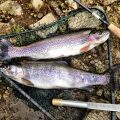Lingcod are more commonly referred to as a fish with an identity crisis — Lingcod, as the
name suggests, is type of fish that blurs the line between a cod and a ling.
It’s neither of the two, but a pacific greenling belonging to the family
Hexagrammidae.
It’s obvious that the fish got its name ‘ling’ from the early settlers who thought it looked
a lot like the European ling but also comported with the fact that it took the
white flaky flesh from the cod, hence the name lingcod. However, back in the
early 1900s, people could refer to the fish as Cultus cod. But this came off as
an insult considering Caltus meant something of little value in Chinook.
Scientific Background
Lingcod is generally a pacific species of fish. It’s scientific name, Ophiodon Elongatus,
describes it to a T. Starting with its root name Ophis and odons, which in
Greek translates to ‘snake’ and ‘tooth’ respectively — and then there’s the
second piece of the name, ‘elongatus,’ another fitting description for this
elongated, odd-looking fish. In which case, the only thing distinguishing the
bottom-dweller fish with a serpentine is its enlarged head, hence the name
‘Buckethead’ as some people call it.
Known to live in rocky seafloor, the fish has a habit of camouflaging in mottled colors that range from deep browns and
mustard yellow to dark green and varied greys. The marine environment has also
been found to influence its marking and coloring. The fish’s fillet features a
natural blue-green shimmer that will be disappearing when cooking. Its meat is
favored for the mild flavor and the dense flesh that makes it suitable for
preparing a dish of fish and chips.
Spawning
Lingcods are known for migrating during the month of October is search of favorable spawning
grounds near the seashore. It begins with the male leading the way as they try
to establish favorable nesting ground on ledges and rock crevices with strong
currents. They’ll be shortly after followed by the females that will be laying
150, 000 to 500, 000 eggs in the secured nests. Once the females are done
laying the eggs, they’ll immediately take off leaving the males to guard the
laid eggs against predators. It will take approximately six to seven months for
the eggs to hatch — that’s between March and April. The hatched Larvae will
first move to eelgrass beds where they’ll stay shortly before moving to a flat
sandy area.
Young lingcod will continue inhabiting shallower depth for a number of years, and
eventually move to the deeper part of the sea to join older lingcod. Generally,
the species has an average life span of 14 to 20 years and may grow up to
4.53kgs (10 pounds). The largest Lingcod ever spotted however weighed about
36.3kgs and was about 152 cms long (60 inches).
Mating
The crab’s mate when they’re about 3 years of age. Naturally the females are way smaller
compared to their male counterparts — and that’s because, the female
reproductive tissues use lots of energy to develop, and in the process leave
less amounts of energy for a continued growth of the body. Lingcod grow through
a process called molting, where their shell is regularly shed as it grows into
a larger one, all the way until the fish attains full maturity.
When it comes to mating, crabs will first leave their burrows in droves in what’s
apparently a desperate bid to look for mates. And once the mating occurs, the
females will spawn in water. The larvae will be released during the next rainy
season, during which they’ll remain in the offshores to develop and later —
after five to eight weeks — migrate to coastal waters after the larval
release.
Lifecycle
Lingcod are mostly found in the west coast of North America and the coast of British
Columbia, as well. The fish can be found at the bottom of the sea, with some of
them occupying the rocky areas ranging from the depth of 10 to 100 m. Different
tagging studies consider lingcod as a nonmigratory species of fish, but with
recruitment and localization occurring in the localized areas only.
Lingcod are one of the most voracious predators that will be feeding on anything edible that
fits into their mouth. Their meals range from invertebrates to many species of
fish including the herring, pacific hake, and the salmon to name a few.
Octopuses are among their favorite meals. They can also devour some of the
large rocky fish. A good number of the fish survive the larval stage as they
have a few predators themselves, save for the harbor seals and sea lions.











Pingback: How to Catch Lingcod | Reel Fishing Guru